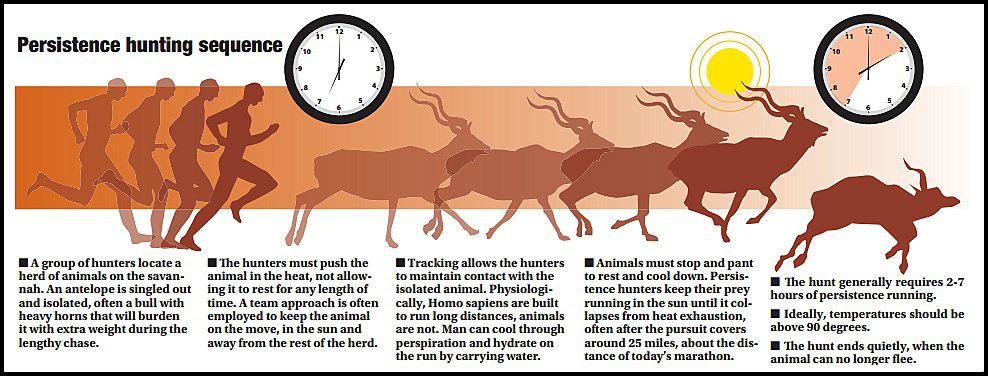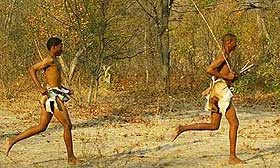Table of Contents Show
✍️ AI is summarizing:
Have you ever wondered why humans are so drawn to running marathons, ultramarathons, or even chasing personal bests in the park? While it may seem like a modern fitness obsession, the answer might be etched into our evolutionary past. The concept of persistence hunting—the ability to track and run down prey over long distances—suggests that we were literally born to run.
This remarkable adaptation not only helped our ancestors survive in harsh conditions but also shaped many of the physical and physiological traits we carry today. In this article, we explore the fascinating theory of persistence hunting, the scientific debates surrounding it, and the evidence that supports its lasting imprint on human evolution.
Related post:
- Doms vs Injury: How to Know if Your Pain Is Normal or a Red Flag
- Combat Emotional Exhaustion: The Power of Outdoor Activities for Better Mental Well-Being
- Brave the Wild: How to Camp Alone Safely and Confidently
What is persistence hunting and why does it matter?

The theory that humans evolved the capacity for endurance running primarily as a means to chase down prey has fascinated researchers and runners alike for decades. This concept, known as “persistence hunting,” suggests that early humans relied on their unique physical traits to outlast animals, and it offers a compelling narrative for our enduring fascination with long-distance running.
Originally proposed in a seminal 1984 paper by researcher David Carrier, the endurance hunting theory posits that running is an integral part of our human identity. It frames our collective passion for running not merely as a modern exercise trend but as a fundamental aspect of what it means to be human. As the adage goes, it is running that “made us human,” connecting our contemporary obsession with endurance sports to our ancestral survival strategies.
The controversy surrounding the persistence hunting theory

However, this theory has faced skepticism within the scientific community. Critics point to two main shortcomings. First, running burns a significant amount of calories, which is a disadvantage for survival in the harsh environments early humans inhabited. Second, historical records suggest that persistence hunting was not a widespread practice among hunter-gatherer societies, hinting that it may not have played a pivotal role in shaping our evolution.
New findings that support persistence hunting
Contrary to these doubts, a new analysis published in Nature Human Behaviour has emerged, providing robust evidence that supports the significance of persistence hunting throughout human history. Other notable researchers have compiled various forms of evidence that argue persistence hunting was not just an occasional occurrence but a valuable strategy utilized by early humans in diverse environments across the globe, from savannas to dense forests and snowy landscapes.
Why humans are evolutionarily built for persistence hunting

Our evolutionary advantages for endurance running are noteworthy. Humans possess many unique traits that make us exceptional long-distance runners. We have a high proportion of slow-twitch muscle fibers, which are crucial for endurance, and our ability to cool ourselves through sweating is unparalleled among mammals. These traits signify that our bodies were naturally selected for efficient running.
Interestingly, the analysis shows that running can actually yield better hunting returns than walking. Although it seems intuitive to track prey at a slow pace to conserve energy, research indicates that running can shorten the time spent chasing prey. By running faster, hunters can capture their target more quickly, thus outweighing the calorie expenditure incurred during the chase.
The legacy of persistence hunting in modern humans

The study also analyzed historical records from various cultures, revealing a plethora of persistence hunting accounts from the 1500s to the 1900s across continents. This research unearthed 391 documented instances of persistence hunting, suggesting its widespread practice. Previously, accounts primarily came from environments like the Southern African savanna; however, the new data highlight diverse instances, including native Hawaiians chasing goats and Indigenous peoples in North America hunting deer.
This breadth of evidence indicates that persistence hunting was a common human activity, shaping our evolutionary trajectory and fueling our inclination for running as a recreational pursuit today. It serves as a reminder that while modern conveniences have altered our lifestyles, the innate drive to run is deeply embedded within our biology and history.
Conclusion
In conclusion, the exploration of persistence hunting not only illuminates our past but also reinforces the idea that we are biologically predisposed to run, making it an essential aspect of our human experience. We were truly born to run, a legacy that continues to resonate in our lives. Stay updated with all things ExoTrails! Follow us on Facebook for the latest news, travel stories, and inspiration.












